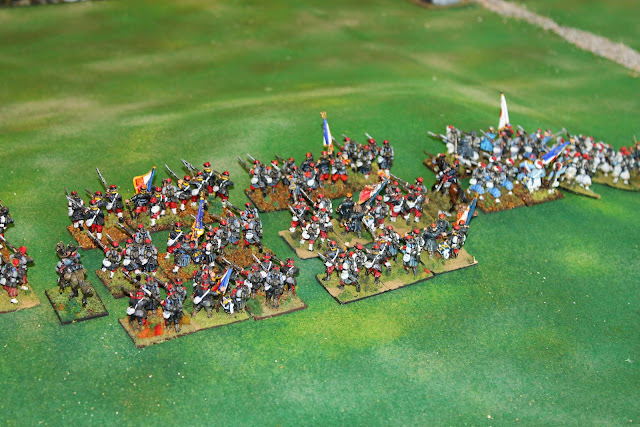The objective of the Prussians was to secure the road that led off the table toward the river crossing. The French objecitive was to deny the Prussians control of the road.
The terrain was relatively open with two parallel ridges. Between the ridges was a village.
The French were permitted to deploy 350mm in from the table edge, with the exception of the six batteries of the reserve artillery that had to move onto the table after the first turn. The French chose to deploy on the reverse slope, with a division either side of the road. They chose to bring the reserve artillery on between the divisions, opposite the village.
The Prussians could deploy 300mm in from the table edge. Their divisional artillery could be deployed, but the six batteries of the reserve was in limber. They too chose to deploy either side of the road. The division on the right was to push one brigade through village. The reserve artillery and the cavalry brigade were also assigned here.
For the first turn the French remained concealed behind the ridge, while their reserve artillery arrived on the table. The Prussians, meanwhile, deployed all their artillery while one brigade occupied the village.
On turn two the French reserve artillery rolled into position. At the same time the French divisional artillery came forward to cover the reserve's deployment. This commenced a battle for fire superiority that lasted for the next four turns. At first the French guns held their own against superior numbers, but in the end the numbers began to count and the French batteries were being driven off or destroyed one by one.
With fire superiority achieved the Prussian right hand division prepared to step off. Then a battalion of French chasseurs à pied rushed forward and occupied a small farm on the Prussian flank. The Prussians were compelled to turn three battalions to neutrailise this threat, while the remaining nine battalions advanced.
As the Prussian reached the foot of the ridge, the French pushed to the top of the ridge and opened fire, but failed to halt the Prussian advance. When they attempted to close the French stopped the advance with a second volley then counter attacked and drove back three Prussian battalions. But when the French attepted to push the advance further the Prussian gun mass held them in check.
At that moment the other Prussian division went forward. The brigade on extreme the left was abruptly halted by the French divisional artillery and pushed back, but the right hand brigade, assisted by some battalions from the other Prussian division, forced the French back.
At that moment the Prussians on the right pushed forward again, gaining the flank of the French, driving them back. A large gap was opened in the French centre and the Prussian established themselves in a dominant position astride the road to the bridge. Unable to dislodge the Prussians the French broke off the action.
It was a good game lastng for six hours. It was good to see theses armies out if their boxes, for the first time since November 2012.





Fantastic looking game - now that is proper wargaming.
ReplyDeleteFPW is still on my long term project list, after this posting I might just have moved a little closer.
Cheers
Stu
Thanks Stu.
DeleteFPW had held interest for me since the early 1970s , in part from Featherstone books and in part from studying the Wars of German Unification in sixth form history, but not until the Foundry figures appeared in 1985 did my obsession with this period really gear up.
The game worked really well although I must admit the terrain was a little bland for my liking, but that was just a shortage of time.
I changed some structure of the forces (French battalions were 3 stands and the Prussians 4) and the fairly basic mechanism of not removing stands as casualties and replacing them with hit markers – four accumulated hits and the unit is disrupted (with some combat implications) or six hits and the unit is shaken (with some serious implications). There was still some post-match tweaking, but the rules are probably reaching a pretty mature state now. I will apply these changes to all the period variants that we play – ACW, RJW, Napoleonic, WSS, Austro-Prussian and WWI.
I found the hit markers a bit messy so I am looking at a solution of a rotating disk set into the command base. I am going to speak to someone who has a 3D printer about designing this.
Very handsome game!
ReplyDeleteThank you. It was lots of fun!
DeleteExcellent! Glad to see someone else playing FPW, not often played...great pictures and minis!
ReplyDeleteThanks Phil. FPW has always been a favourite of mine, but the interests of our group are so diverse we don't get to play it as often as I would like. I was really impressed with your Quatre Bras game - we too have played it several times.
ReplyDeleteSo many interesting periods to play and so little time!
Delete